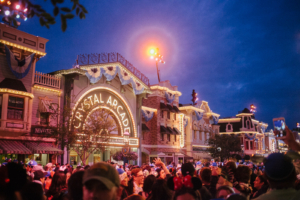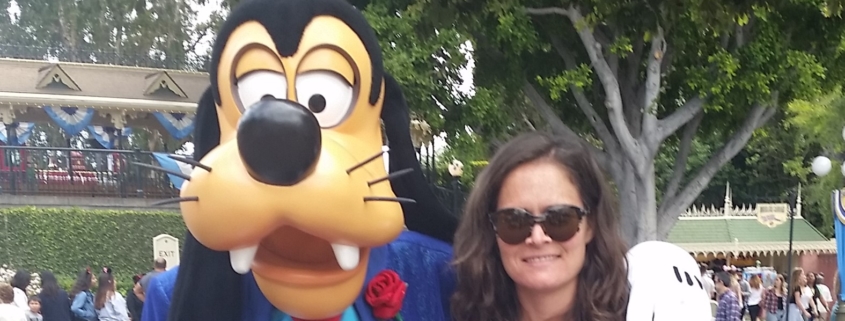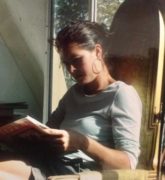The Model World
I think I’ve been to Disneyland twenty times since November 2016. I live in Orange County, about fifteen minutes from the park, and most days I wait till school is out so I can take my daughters with me. But I also go alone. I’m thirty-six. As kids growing up in San Diego, my sisters and I went with our parents to Disneyland once a year, usually for our birthdays or some special occasion. But when I moved home from college I bought an annual pass, which I’ve renewed in most subsequent years. When I have an afternoon off, I drive over and park in the adjacent mall. I walk to the park’s turnstiles in a sort of fugue. Sometimes I ride the rides but mostly I just walk around because, inside the park—in that battery of smells and noise and light—I am calmed. And, through the cotton-candy haze, I have formed a theory to answer for my obsession—one that I think extrapolates to a broader American problem. I know what you’re thinking. This woman is desperate to justify an infantile fixation with Disneyland. And that’s also true. But hear me out.
This is how it is: I step onto the cobblestone sidewalk, and a false town unfurls ahead. Somewhere nearby a train whistle blows. The machinery of the steam engine begins to catch and clack and catch. A pole rises in the middle of the Main Street roundabout; at the top an American flag rolls and snaps. Slowly, I move into the throng. I have not come here for rides at all; I have come because I love a well-told story.
Main Street, Disneyland is the area least changed in the park. It’s supposed to replicate the central avenue of Marceline, Missouri, where Walt Disney grew up. He aimed to evoke the year 1910, the era of his grandparents, which he referred to as simpler and safer. Though, somewhere in our consciousness, we know that nothing is ever truly simple, nothing truly safe, at least not in the immaculate, cartoon sense of Main Street, guests happily fold into the farce. The fabrication of a better, bygone time is so complete that we can almost taste the memory, even those of us who were (for example) born the year Reagan was elected, those of us who were not there. We have absorbed stories about America’s place on the right side of history.
The memory of our national goodness is as close as the smell of burnt sugar and popcorn butter and the sweat of Clydesdales. The memory is as tidy as flower planters filled with purple larkspur, blueish lobelia; girlish impatiens; petunias that point up like tiny gramophones; hearty pink mums and dainty sweet alyssum—all sown with geometric precision. There are 150 full time gardeners who tend the Disney beds at night, and in the heat of the day, when those workers have disappeared, the humus rising off the new-churned soil hints at authentic earth. The buildings lining Main Street are painted the pastels of salt water taffy. Mansard roofs sit atop their facades like sturdy hats. Turned finials poke daintily toward the sky and striped awnings sweep out from eaves like ladies’ skirts; their scalloped edges ruffle prettily when a breeze blows. And in the air everywhere there is a song, a never-ending song. A lilting tune. Something jaunty from Back Then.
* * *

Photo credit: Mary Birnbaum
After the 2016 election I took to the Internet like a fiend, looking for answers. The liberal web had devolved into a great howl. Never a user of the platform before, I refreshed Twitter like I had a tic. I read the news and any blog I could find, trying to dismantle the election riddle, to pop my own bubble. Slowly, we tuned to mounting evidence that the election result was a product of Trump’s collusion with Russia, but we were also awakened to an equally (if not more) disconcerting reality. Trump voters weren’t just a couple dudes in rumpled KKK robes who’d been living in caves since the alleged end of Jim Crow. They were people we knew, who had found a way to look past hate speech and buffoonery because they’d been sold a promise: that, though we had gone to bed in black and white, we would wake up in the Technicolor version of our Great American past. The trouble with US history as invoked by Trump’s marketers is that, like all beguiling stories, it’s an elaborate fiction that presents us as the people we think we are, but whom we have never been.
Nostalgia is nowhere more tangibly realized than at Disneyland. There is something more than escapism at play. People who go to Disney are looking for something they think they’ve lost. When they arrive, they find the facsimile of a kind of home, even though there is something uncanny about the place, something perhaps sickly sweet. The illusion is effective because, through clever engineering and attention to detail, it sidles just close enough to reality. That’s what advertising does, and that’s what Trump did so effectively: he told Americans that if they were unhappy it was because the American people had been set adrift, and his plan was to restore us to that once-great place.
* * *
When he conceived Disneyland, Walt Disney sought to manifest a place of simultaneous forgetting and remembering. At the moment, the park is comprised of eighty-five acres, though that area will expand as construction finishes on Star Wars Land. Disneyland is big enough to get lost in, grand enough to be immersive. There is no hint of the external world; no freeway noise, no horns, no sirens of any kind. A person can walk and walk for hours without stopping, though they will ultimately be walking in circles of various size. My friend who wears a pedometer to the park says if she spends the day there, she’ll have walked about five miles.

Photo credit: Katy Regnier
There are no street corners in the park. Where sidewalks should meet at right angles, instead they curve. The detail was executed to soften the feel of the park, inducing ease and comfort by literally eliminating hard edges. And removing corners is only the beginning of various subtle effects Disney perpetrates. The scope of the place is designed to make people feel significant. Buildings on Main Street are a two-thirds scale rendition of actual buildings, which was supposedly an effort by the park’s designers to make children feel larger. They wanted kids to enjoy a stature here that they knew nowhere else. But the effect also means that adults in this demi-city are slightly over-sized.
It is in this peculiar, pretend place that I think I can meet the person who voted for Trump. I meet them in the simplistic dream of safety and calm. There is no nuance, no complexity at Disneyland; there is only a beautiful fiction. America—or a pretty vision of it—has been so carefully constructed in this place that, for the length of a visit, it’s possible to imagine our country is a fixed idea.
This is not an attempt to infantilize Trump voters. I know there are many of them who are kinder and smarter than I. And like I said, I am as susceptible to a good story as anyone. But I know something about the dance of Disneyland, I have made something like an ethnography of it, and I think it’s analogous to the tricks of the Trump campaign. He made a platform of simplistic reasoning, designed for those exhausted by the rigors of political correctness and critical thought. The candidate did not have to be eloquent; he was, in fact, strategically inarticulate. Linguists have described his style—one riddled with non-sequiturs and fragments—as effectively conveying a feeling rather than a specific message. With varying degrees of coherence, he reduced American unhappiness to a battle of us versus them, a stance both internally and internationally isolationist, with terror as a backdrop. It’s probably pertinent to mention here that Bob Iger, the current CEO of Disney, is on the president’s strategic and policy advisory committee. For once, at least as it concerns storytelling, Trump actually tapped the Best People.
I go to Disneyland to still my anxious heart, to reduce the post-election clatter of my mind. But I know that even the simplest place—the so-called Happiest Place—cannot really claim that distinction. 1955 wasn’t simple and safe enough for Walt Disney; he tried to reconstruct 1910. Now America is trying to get back to 1955 or anywhere, any year when they think they were not afraid. Disneyland cannot escape complexity because its very genius is in attention to detail and the close reproduction of reality. And reality is inevitably complex. On YouTube a couple years ago I found the original hour-long ABC broadcast of Disneyland’s opening day. Though it’s in black and white, you can see that July 17th, 1955 was a meltingly hot day. A series of glistening TV anchors, including Art Linklater and then-actor Ronald Reagan lead a tour of the new park, section by section. On the way they talk to visiting families and celebrities. It is Reagan who holds the anchor’s mic to interview Fess Parker, AKA Davey Crockett, when he rides into Frontierland on a sweaty horse. Parker apologizes for his tardiness, on account of having been waylaid by a band of “redskins.” Luckily, he adds, tapping his rifle, “Old Betsy” saved the day. Reagan chuckles for the camera. Just then a cast of dancing cowboys breaks into a tune called “My One and Only Betsy,” in apparent ode to the firearm. In a following segment, Aunt Jemima (at this point portrayed by the actress Aylene Lewis) is seen dancing a vigorous Charleston alongside other revelers in what would eventually become New Orleans Square.
The tropes modify, politics change, the world heaves and shudders and Disney always adapts. The guns aren’t loaded anymore, but there’s still a shooting gallery in Frontierland.
You can side-step the truth if you successfully approximate it. Trump beat us, and he will continue to beat us, because he staffed his ranks with adept storytellers and mythmakers. America did not want the truth; it is too rife with complexity and nuance and struggle. As our moral arc maybe (and this is really a maybe) had started to bend toward justice, partially as issues of racism and misogyny and poverty and privilege came to the fore, the deep red, beating heart of the country sped up. They didn’t want to feel guilty and afraid. America wanted a hot milk and a lullaby. The answer would seem to be that we must fight story with story. But Trump’s anodyne message is hard to combat. It is, unfortunately, as old as it is inaccurate.
In June my family and I are moving back to San Diego. We won’t be at Disneyland’s doorstep anymore. The change will suit my dog Wyatt just fine; nightly the park’s fireworks rumble like a distant shelling, and he is very sensitive to noise. I think this year I will not renew my pass. Though I will never stop wanting to be there, inside the easy story, I think the time for platitudes, the time for calm, is long past. And, though the buildings have real doors, they are always shut, and the curtains are always drawn; no one really lives on Main Street.


 Mary Birnbaum is the Lunch Ticket blog editor and editor of the Diana Woods Memorial Award in Nonfiction. She studies creative nonfiction in the Antioch LA MFA Program. She resides in Orange County, California. You can find her on Twitter @ailishbirnbaum
Mary Birnbaum is the Lunch Ticket blog editor and editor of the Diana Woods Memorial Award in Nonfiction. She studies creative nonfiction in the Antioch LA MFA Program. She resides in Orange County, California. You can find her on Twitter @ailishbirnbaum


